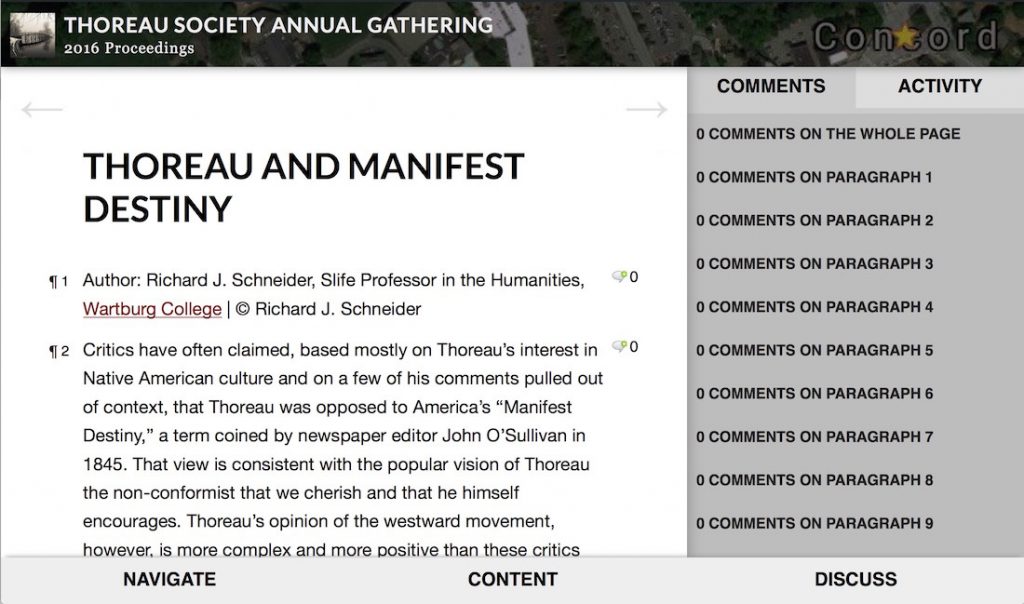Robert M. (Bob) Young is a member of the Thoreau Society and the author of Tramping Monadnock! New Discoveries with Henry David Thoreau. The author thanks Digital Thoreau editors Paul Schacht and Beth Witherell for their assistance in writing this post.
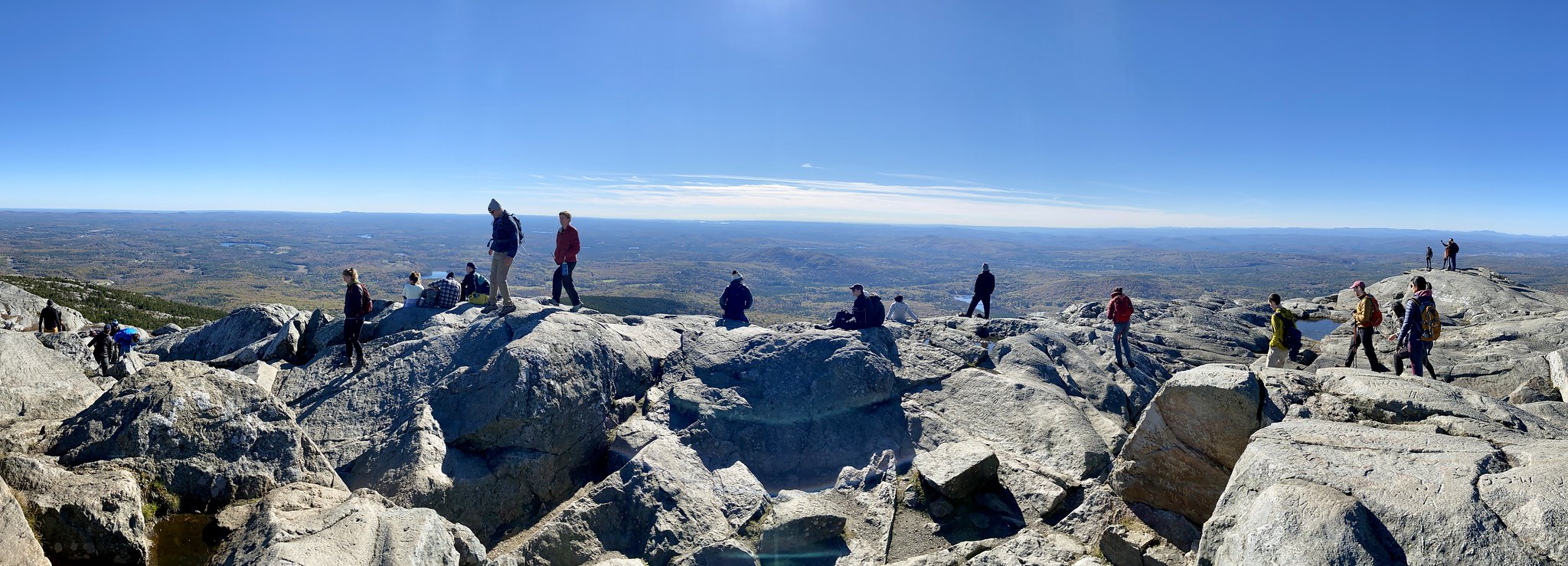
Climbers at the summit of Mount Monadnock. In Thoreau’s time as in ours, the mountain was a popular tourist attraction. Mt. Monadnock summit view by Robert Laliberte on Flickr, CC-BY-NC 2.0.
At 8:30 a.m. on August 4, 1860, accompanied by his close friend Ellery Channing, Thoreau set off from Concord on what was to be his fourth and final visit to “one of his favorite mountains,” as Walter Harding tells us: Mount Monadnock in New Hampshire (Harding 1982, 171). He’d made his first visit in 1844, traveling alone. Now, with Channing, “who had never been camping before,” he slogged “straight through a rainstorm,” writes Laura Dassow Walls, “to the very same hollow on Monadnock’s summit where he and [H. G. O.] Blake had camped two years before” (Walls 2017, 469).
In Journal entries dated August 4 through August 9, Thoreau provides a chronological account of the 1860 excursion. (See Journal 1906, 14:8-52.) In the entry for August 9, he includes lists and descriptions of the natural phenomena he observed, and he draws a map of the mountain that includes bearing lines and several of the features mentioned in his account.
In my self-published monograph Tramping Monadnock! New Discoveries with Henry David Thoreau (available in print from The Shop at Walden Pond, Lulu, or Amazon, and in several digital formats at the Internet Archive) I describe my effort to retrace Thoreau’s four journeys, walking the roads and paths he walked, riding the rail lines he rode, seeking, as I went, answers to a number of practical, scientific, and philosophical questions. For example, after his death, what became of the pocket compass that Thoreau used on his Monadnock journeys, as well as many others? (Spoiler alert: for a time, at least, it was in the possession of the poet Emma Lazarus. Chapter Eight of Tramping Monadnock! explains how she came into it and where it went next.) What did Thoreau learn about nature from these four trips? What did he learn about place? About life?
Thoreau never wrote an essay, lecture, or book exclusively focused on Monadnock. What we know about his four trips there comes mainly from the Journal and his correspondence. The map Thoreau drew as part of his Journal entry for August 9 is something else I sought to understand better by following in his footsteps.
Although I discuss the map at length in Tramping Monadnock!, the book’s format limits my ability to explore it closely with readers and share everything I’ve come to appreciate about it. In this blog post, I can display a higher-resolution image of Thoreau’s drawing and zoom in more easily on some of its most interesting details.
Let’s take a look.
Mapping Monadnock
By the time of his final visit, Thoreau was on a quest to understand the unifying principles beneath nature’s diversity. He’d encountered Darwin’s Origin of Species, and he’d begun mining his Journal to create a series of phenological tables recording the dates when various natural phenomena in Concord took place each year, sometimes referring to these as his “Kalendar.” As Walls explains, he embarked on this last trek up Monadnock with a mission: “to study everything, get the whole big alpine picture in one place” (Walls 2017, 468–469). His notes fill more than twenty-five printed Journal pages: “scores of plants, from trees to grasses to lichens; birds, both visiting and resident; mammals (only two, rabbit droppings and a porcupine skull); insects, frogs—and people, of course, and their ways of making the mountain their own.”
“Thoreau mapped the summit,” Walls continues, “studied the bogs, and decided which rivers drained out of each. He sketched the rocks and described their glacial grooves, aligned so precisely northwest to southeast they could have steered him in a fog” (Walls 2017, 469). In his Journal entry for August 8, Thoreau describes taking bearings from the summit: “Walk round the west side of the summit. Bathe in the rocky pool there, collect mountain cranberries on the northwest side, return over the summit, and take the bearings of the different spurs, etc. Return to camp at noon” (Journal 1906, 14:25). In his entry for August 9, he explains his ingenious method for taking the measurements he needed for his map: “The basis of my map was the distance from the summit to the second camp, measured very rudely by casting a stone before. Pacing the distance of an easy cast, I found it about ten rods, and thirteen such stone’s throws, or one hundred and thirty rods, carried me to the camp. As I had the course, from the summit and from the camp, of the principal points, I could tell the rest nearly enough. It was about fifty rods from the summit to the ravine and eighty more to the camp” (Journal 1906, 14:39).
In Thoreau’s time as in ours, Monadnock was a tourist destination. Thoreau estimates that at least five hundred people came to the summit during the four full days he and Channing were camped there (Correspondence 1958, 597). Unlike them, he writes in his Journal, “I came not to look off from it but to look at it” (Journal 1906, 14:39). In the August 9 entry, his map of the mountain (recto) is on the page facing the last part of his description of the tourists (verso).

Verso
Images courtesy of The Morgan Library & Museum

Recto
Thoreau’s description of the tourists begins on the page of his Journal preceding the one above, whose first words are “The young men sat in rows with their legs dangling over the precipice–”. Here’s the description in full.
There were a great many visitors to the summit–both by the S & N (i.e the Jaffrey &
Dublin paths) but they did not turn off from the beaten track. One noon when I was on the top–I counted 40 men women & children around me. & more were constantly arriving while other were going. Certainly more than 100 ascended in a day– When you got within 30 rods you saw them seated in a row along the gray parapets–like the inhabitants of a castle on a gala day–& when you behold Monadnock’s blue summit 50 miles off in the horizon–you may imagine it covered with men women & children in dresses of all colors–like an observatory on a muster field.
They appeared to be chiefly mechanics & farmers boys & girls from the neighboring towns. The young men sat in rows with their legs dangling over the precipice–squinting thro’ spy glasses–& shouting & hallooing to each new party that issued from the woods below–
Some were playing cards. Others were trying to see their house or their neighbor’s. Children were running about & playing as usual. Indeed this peak in pleasant weather is the most trivial place in New England–there are prob. more arrivals daily than at any of the white mt houses. Several were busily engraving their names on the rock with cold chisels–whose incessant chink you heard–& they had but little leisure to look off. The mt was not free of them from sunrise to sunset–though most of them left about 5 Pm. At almost any hour of the day they were seen wending their way single file in various garb up or down the shelving rocks of the peak–
These figures on the summit seen in relief against the sky (from our camp) looked taller than life. I saw some that camped there, by moonlight one night.
On Sunday, 20 or 30 at least, in addition to the visitors to the peak–came up to pick blueberries & we heard on all sides the rattling of dishes & their frequent calls to each other.
An upside-down map?
Thoreau wouldn’t have drawn the map that follows this description, or recorded any of his other notes, while out and about at the summit, as it wasn’t his practice to take his precious Journal volumes into the field. Instead, he typically jotted down information in a small makeshift notebook and later worked these up into Journal entries. It’s interesting that when he did come to draw the map, the result was not easily readable without turning the Journal upside down.
Not surprisingly, Houghton Mifflin’s 1906 edition of Thoreau’s writings prints the map rotated by 180 degrees. Rotating the map not only makes Thoreau’s labels easier to read; it also puts North at the top of the page, where most readers are used to seeing it.
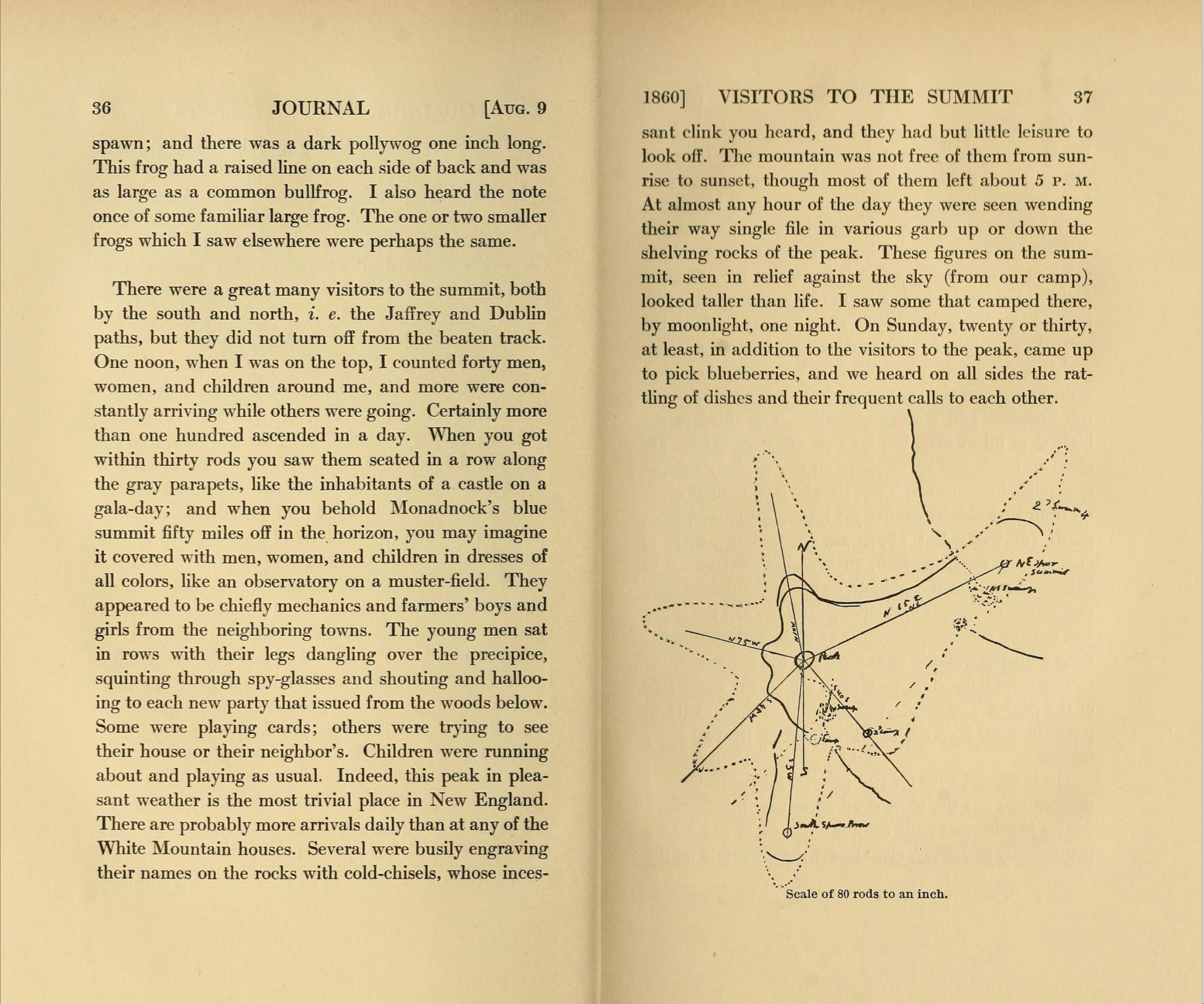
Thoreau’s Journal. Source: Internet Archive.
But it’s unlikely that Thoreau began drawing the map “North up.” There’s no obvious reason why he should have wanted to turn his Journal upside-down before setting pen and pencil to paper, though we can’t rule out the possibility that he found drafting easier with the blank page on the left rather than the right. It seems more probable that he began drawing the mountain from his south-facing perspective on the summit, guided by the bearings and measurements he had taken there, which are indicated on the map by the radiating lines in pencil with labels such as “s5w,” “S45W,” and “N65E.” The varying orientation of these labels makes it clear that Thoreau must have rotated the Journal volume repeatedly in adding them. It’s pretty clear, though, that at some point he decided he wanted the map to have a “North up” orientation.
Here’s a larger view of Thoreau’s map.

And here’s the map rotated 180 degrees.

Judging by the hooked ascender of the large capital “N” for North, Thoreau had already decided on a “North up” orientation for the finished map by the time he added that label. (Compare the capital “N’s” in his other labels on the map.)
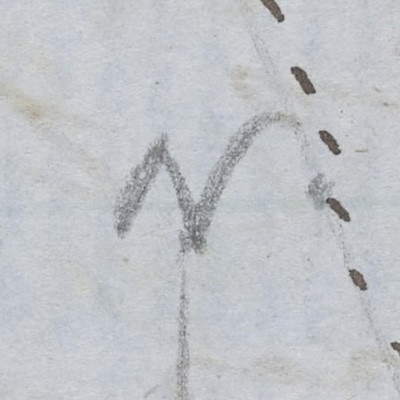
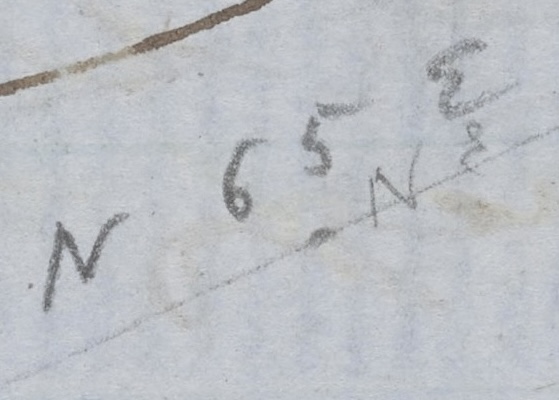
Thoreau’s “N” for North (when map shows North at top) and Thoreau’s bearing labels “N 65 E” and “NE”
In any event, the outcome of Thoreau’s process was a map that, viewed with the Journal volume in its normal orientation, showed the landscape as it appeared to Thoreau on the summit, and turned around, showed that same landscape as it would appear on a conventional map. Whether intended or not, this “choose your own perspective” result is certainly consistent with Thoreau’s interest in representing nature so as to include his own subjectivity as observer. As the website “Thoreau’s Kalendar” explains, Thoreau’s phenology project, which combines meticulous observation of seasonal phenomena with details of “Thoreau’s own activities and seasonally-determined behaviors,” reflects his dissatisfaction with the detached stance he saw dominating the science of his time. “I think that the man of science makes this mistake, and the mass of mankind along with him:” he writes in his Journal entry for November 5, 1857, “that you should coolly give your chief attention to the phenomenon which excites you as something independent on you, and not as it is related to you. . . . With regard to such objects, I find that it is not they themselves (with which the men of science deal) that concern me; the point of interest is somewhere between me and them (i. e. the objects)” (Journal 1906, 10:164–165).
In Walden (“Where I Lived, and What I Lived For”), Thoreau imagines housing himself in a variety of locations before the one he ultimately selects by the pond. No matter the location, “Wherever I sat, there I might live, and the landscape radiated from me accordingly,” he writes, sounding like a modern-day practitioner of phenomenology. In the chapter “The Pond in Winter,” he includes a survey map of the pond that captures his perspective from the home he built by a cove on the pond’s north shore. Like his map of Monadnock it consequently puts South at the top, so that the pond appears “upside down” when compared to what we see on most maps. (He helpfully includes the word “House” at lower right, and an arrow giving the direction of the true meridian.)
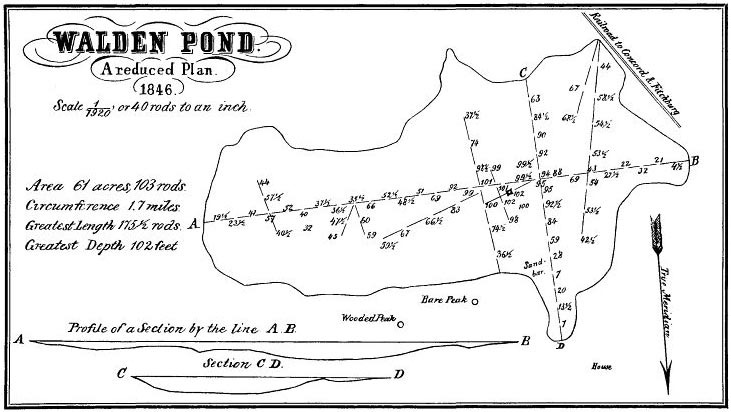
Thoreau’s survey map from the chapter “The Pond in Winter” in Walden
More than just a sketch
The sketch-like appearance of Thoreau’s map belies its precision. As a skilled surveyor, Thoreau was able to make use of the rough measurements he took of the distance from the summit to his and Channing’s second camp and combine these with his accurate bearings of the spurs to produce a remarkably detailed and accurate representation of the mountain. He indicates the map’s scale (“80 rods to an inch”) at the bottom (when the Journal is rotated to put North at the top.)
The StoryMapJS map tour below picks out some of the map’s interesting features. You may find it easier to see some features if you view it full screen (opens in a new tab/window).
The map tour moves you from one location marker to another, connecting these markers with lines to indicate your progress. But you can also use your mouse to move around freely on the map by clicking, holding, and dragging. If the correlation between map and text gets scrambled, use the link at top left to return to the beginning of the tour. You can resume where you left off—or choose some other location to visit—by clicking on a location marker. If slides fail to advance fully, refresh your browser and start again.
View full screen (opens in a new tab/window)
Works Cited
Thoreau, Henry D. 1906. The Journal of Henry David Thoreau. Edited by Bradford Torrey and Francis H. Allen. 14 vols. Houghton Mifflin and Company.
The Correspondence of Henry David Thoreau. 1958. Edited by Carl Bode and Walter Harding. New York University Press.
Harding, Walter. 1982. The Days of Henry Thoreau. Princeton University Press.
Walls, Laura Dassow. 2017. Henry David Thoreau: A Life. University of Chicago Press.






